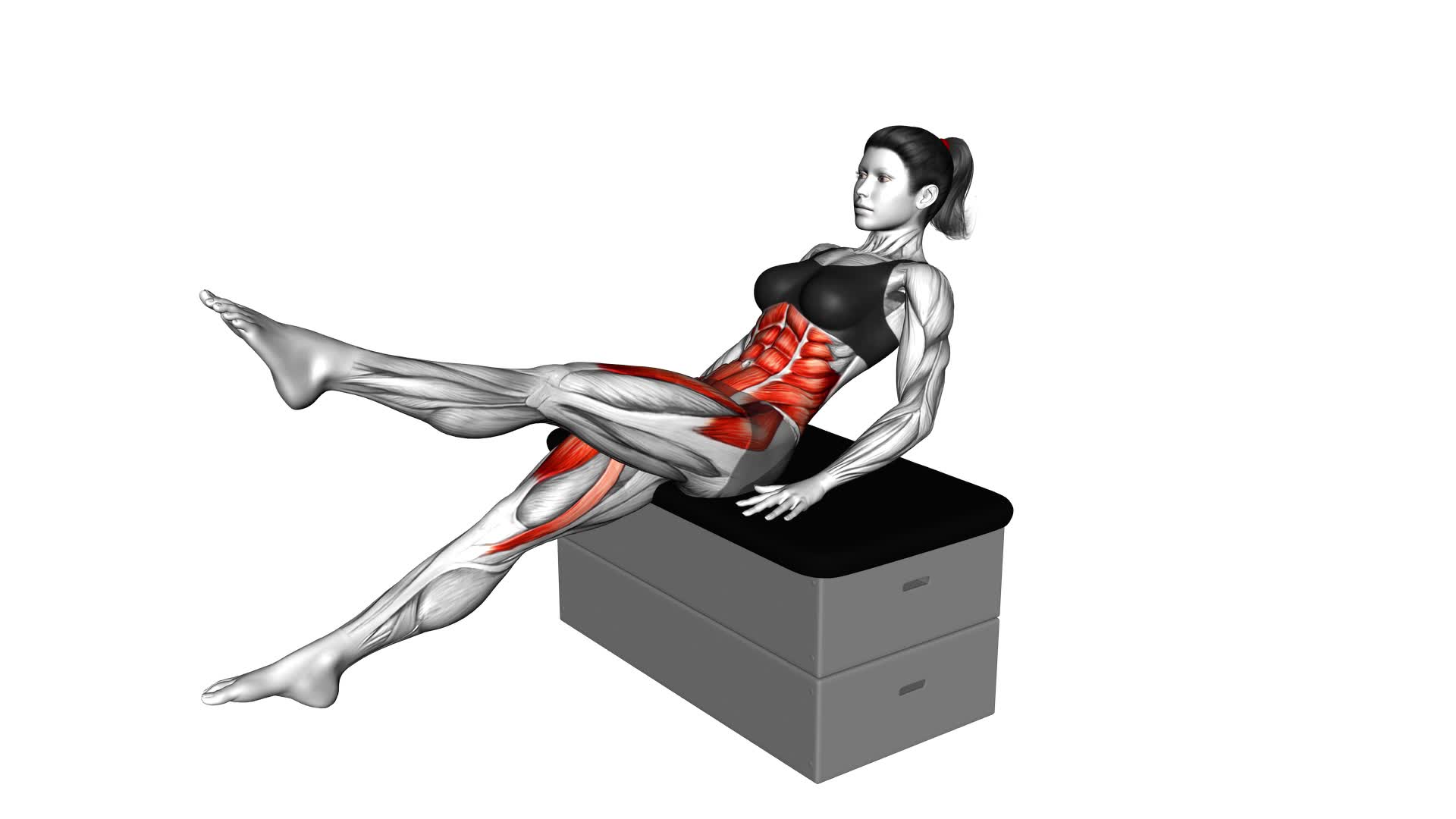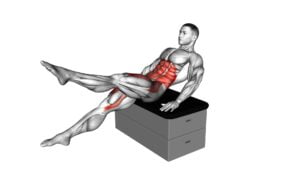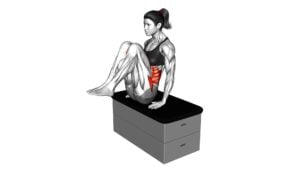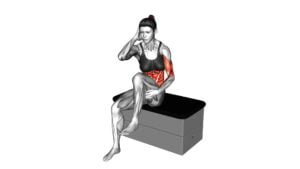Sitting Flutter Kick on a Padded Stool (Female) – Video Exercise Guide & Tips

Are you looking for an effective way to strengthen your core and improve your posture? Look no further than the sitting flutter kick on a padded stool.
Watch This Exercise Video
This exercise targets your abdominal muscles while also engaging your legs and glutes.
In this video exercise guide, you'll learn the proper form and technique to get the most out of this exercise.
With variations to challenge yourself and helpful tips for beginners, you'll be on your way to a stronger core in no time.
Key Takeaways
- Sitting flutter kicks on a padded stool target abdominal muscles, engage legs and glutes, improve core strength, and increase leg muscle endurance.
- Proper form and technique include using a stable and cushioned seat, sitting with a straight back and feet flat on the ground, placing hands on the sides of the stool for support, and making small, quick kicking motions with toes pointed.
- Common mistakes to avoid are using momentum to lift legs, allowing the lower back to round, failing to engage core muscles, rushing through the movements, and losing control and stability.
- Variations to challenge yourself include incorporating weighted ankle cuffs, choosing appropriate weight for your fitness level, maintaining proper form and technique, extending legs forward in a fluttering motion, and increasing intensity to target lower body muscles.
Benefits of Sitting Flutter Kick
The Sitting Flutter Kick exercise on a padded stool offers several benefits for you. This exercise is great for improving your core strength and increasing your leg muscle endurance.
By sitting on a padded stool and performing flutter kicks, you engage your core muscles, including your abdominals and lower back, to maintain stability and balance. This constant engagement of your core muscles helps to strengthen them over time, leading to improved core strength.
Additionally, the flutter kicks target your leg muscles, including your quadriceps, hamstrings, and calves. These muscles work together to perform the kicking motion, which helps to increase their endurance.
As you continue to perform the Sitting Flutter Kick exercise on a padded stool, you'll notice that your core strength improves, allowing you to maintain better posture and stability in your daily activities. Your leg muscles will also become more resilient, enabling you to perform activities that require sustained leg strength for longer periods of time.
Incorporate this exercise into your routine to experience the benefits of improved core strength and increased leg muscle endurance.
Proper Form and Technique
To perform the Sitting Flutter Kick exercise on a padded stool with proper form and technique, follow these steps:
- Use a stable and cushioned seat, such as a padded stool.
- Sit on the stool with your back straight and your feet flat on the ground.
- Place your hands on the sides of the stool for support.
- Begin the exercise by lifting one leg off the ground and extending it straight in front of you.
- Keep your toes pointed and your leg straight as you make small, quick kicking motions.
- Alternate between lifting and kicking each leg for the desired number of repetitions.
To maintain proper form and technique during the exercise, be aware of common mistakes to avoid:
- Do not use momentum to lift your legs.
- Avoid allowing your lower back to round.
- Engage your core muscles throughout the exercise to stabilize your body and prevent excessive movement.
- Focus on maintaining a controlled and steady pace, rather than rushing through the movements.
The Sitting Flutter Kick primarily activates the hip flexors and abdominal muscles. The fluttering motion targets the rectus abdominis, obliques, and transverse abdominis, helping to strengthen and tone your core. It also engages the hip flexors, including the iliopsoas and rectus femoris, promoting flexibility and stability in the hips.
Now that you understand the proper form and technique for the Sitting Flutter Kick, let's move on to variations that can challenge you even more.
Variations to Challenge Yourself
To further challenge yourself, try incorporating weighted ankle cuffs into your Sitting Flutter Kick exercise. Adding ankle weights will increase the intensity of the workout, targeting your lower body muscles even more effectively. These advanced modifications are perfect for those looking to take their workout to the next level.
When using weighted ankle cuffs, make sure to choose a weight that's appropriate for your fitness level. Start with lighter weights and gradually increase as you become stronger and more comfortable. It's important to maintain proper form and technique throughout the exercise to avoid any strain or injury.
To perform the Sitting Flutter Kick with weighted ankle cuffs, sit on a padded stool with your back straight and your hands supporting your body at your sides. Place the weighted ankle cuffs on both ankles. Begin by extending one leg forward and then the other, in a fluttering motion. Keep your core engaged and maintain a steady pace throughout the exercise.
Incorporating weighted ankle cuffs into your Sitting Flutter Kick won't only challenge your muscles but also help you build strength and endurance. Remember to listen to your body and adjust the weight and intensity as needed. Keep pushing yourself and enjoy the results of your hard work.
Tips for Beginners
If you're a beginner, focus on building a strong foundation by mastering the basic techniques of the Sitting Flutter Kick exercise. To help you get started, here are some tips to keep in mind:
- Maintain proper posture: Sit up straight on the padded stool with your hands gripping the sides for support. Keep your core engaged and your back flat throughout the exercise.
- Start with small movements: Begin by practicing small, controlled kicks to get the hang of the movement. As you become more comfortable, gradually increase the range of motion.
- *Common misconception*: One mistake beginners often make is trying to kick too high right from the start. Remember, it's important to start with manageable movements and gradually progress to more challenging ones.
- *Beginner mistake*: Avoid using momentum to swing your legs. Instead, focus on using your abdominal muscles to initiate the movement and maintain control.
- Breathe rhythmically: Coordinate your breathing with the movement. Inhale as you lower your legs and exhale as you kick them up.
- *Common misconception*: Some beginners hold their breath while performing the exercise. Remember to breathe continuously throughout to optimize oxygen flow and maintain your energy levels.
By following these tips, you'll be on your way to mastering the Sitting Flutter Kick exercise.
Now, let's move on to discussing safety precautions and modifications to ensure a safe and effective workout.
Safety Precautions and Modifications
Ensure your safety and make necessary modifications while performing the Sitting Flutter Kick exercise on a padded stool. Safety modifications are important to prevent injuries and ensure a safe and effective workout. Here are some key points to keep in mind:
- Stability: Make sure the padded stool is stable and secure before you start the exercise. Check for any wobbling or instability that could potentially cause you to lose balance and fall.
- Proper form: Maintain proper form throughout the exercise. Keep your back straight, engage your core muscles, and avoid any excessive arching or rounding of the spine. This will help prevent strain on your lower back.
- Adjust the height: If you find that the stool is too high or too low for you, adjust the height to a comfortable position. Your hips should be slightly higher than your knees to maintain proper alignment.
- Start slow: If you're new to this exercise or have any pre-existing conditions, start with slower and controlled movements. Gradually increase the speed and intensity as you gain strength and stability.
- Listen to your body: Pay attention to any discomfort or pain during the exercise. If you experience any sharp pain or excessive strain, stop immediately and consult a fitness professional or healthcare provider.
Frequently Asked Questions
How Many Calories Can You Burn by Doing Sitting Flutter Kicks on a Padded Stool?
When it comes to sitting flutter kicks on a padded stool, you might be wondering how many calories you can burn. The effectiveness of these exercises depends on various factors like your weight and intensity.
While it's difficult to provide an exact number, sitting flutter kicks can help you burn calories and engage your core muscles.
To maximize the calorie burn, focus on maintaining proper form and increasing the intensity of your kicks.
Can Sitting Flutter Kicks Help in Reducing Belly Fat?
Sitting flutter kicks can be beneficial for reducing belly fat. They're one of the best exercises for targeting the abdominal muscles. By engaging these muscles, you can strengthen and tone them, ultimately helping to reduce belly fat.
Sitting flutter kicks specifically target the lower abs, which can be a trouble area for many people. Incorporating this exercise into your routine, along with a balanced diet and regular cardiovascular exercise, can contribute to achieving your fitness goals.
How Long Should I Perform Sitting Flutter Kicks to See Results?
To see results from sitting flutter kicks, it's important to perform them for an optimal duration. The duration may vary depending on your fitness level and goals. However, a general guideline is to start with 10-15 minutes per session and gradually increase the time as you get stronger.
To maximize results, focus on maintaining proper form, engaging your core muscles, and increasing the intensity as you progress. Consistency and patience are key factors in achieving your desired results.
Can Sitting Flutter Kicks Help in Improving Posture?
Sitting flutter kicks can indeed help improve posture. By engaging your core muscles, these exercises strengthen the muscles responsible for maintaining proper alignment and balance.
Additionally, as you perform the kicks, you're also working on increasing flexibility in your legs and hips. This combination of strengthening and flexibility can greatly contribute to better posture over time.
Remember to maintain proper form and gradually increase intensity to maximize the benefits.
Can Sitting Flutter Kicks Be Done by People With Lower Back Pain?
If you have lower back pain, sitting flutter kicks may not be suitable for you. It's important to modify this exercise to prevent further discomfort.
Instead, try alternatives that won't strain your lower back. Listen to your body and choose exercises that provide relief and strengthen your core without exacerbating the pain.
Consult with a healthcare professional or a certified trainer who can guide you in finding safe and effective exercises for your specific needs.
Conclusion
In conclusion, sitting flutter kicks on a padded stool can be a beneficial exercise for improving core strength and stability. By maintaining proper form and technique, individuals can challenge themselves with variations to further enhance their workout.
Beginners should take it slow and focus on mastering the basics before progressing to more advanced movements. It's important to prioritize safety by listening to your body and making any necessary modifications.
Incorporating this exercise into your routine can contribute to overall fitness and well-being.

Author
Years ago, the spark of my life’s passion ignited in my mind the moment I stepped into the local gym for the first time. The inaugural bead of perspiration, the initial endeavor, the very first surge of endorphins, and a sense of pride that washed over me post-workout marked the beginning of my deep-seated interest in strength sports, fitness, and sports nutrition. This very curiosity blossomed rapidly into a profound fascination, propelling me to earn a Master’s degree in Physical Education from the Academy of Physical Education in Krakow, followed by a Sports Manager diploma from the Jagiellonian University. My journey of growth led me to gain more specialized qualifications, such as being a certified personal trainer with a focus on sports dietetics, a lifeguard, and an instructor for wellness and corrective gymnastics. Theoretical knowledge paired seamlessly with practical experience, reinforcing my belief that the transformation of individuals under my guidance was also a reflection of my personal growth. This belief holds true even today. Each day, I strive to push the boundaries and explore new realms. These realms gently elevate me to greater heights. The unique combination of passion for my field and the continuous quest for growth fuels my drive to break new ground.







